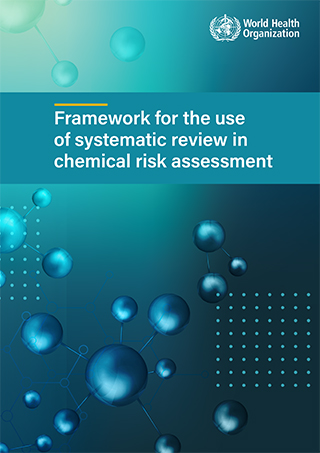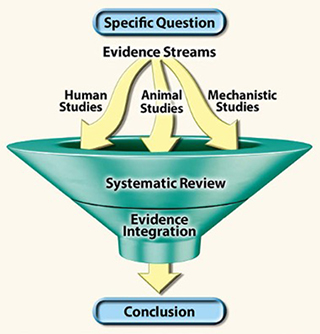By Natalie Rodriguez

In November, the World Health Organization (WHO) Chemical Risk Assessment Network published the Framework for the Use of Systematic Review in Chemical Risk Assessment (framework). This comprehensive guidance document aims to aid chemical risk assessors on systematic review methods.
Since 2013, NIEHS has participated in development, planning, and support for the WHO Chemical Risk Assessment Network . The network was established to bolster global efforts to coordinate discussions, provide a forum for information exchange, and develop training opportunities in chemical risk assessment and management. Network activities are guided by self-organized groups of experts which includes the Systematic Review Working Group.
NIEHS and the National Toxicology Program (NTP) were active in supporting the working group's efforts to develop the document, co-leading the working group and hosting members both in person and virtually to help advance the group's working document.
Chris Weis, Ph.D., serves as the NIEHS liaison to the network and works alongside NTP experts in multiple working groups.

"It's an honor for NIEHS to be a founding member and decade-long partner with the WHO Chemical Risk Assessment Network," said Weis. "Our participation in the systematic review project helps to connect us with other nations and with public health partners worldwide."
Originally developed in the fields of clinical medicine and social sciences, systematic reviews are comprehensive syntheses of the current state of evidence related to a well-defined research question. Their application for addressing environmental health issues continues to grow. Systematic review principles have the potential to advance the rigor and transparency of chemical risk assessments, particularly when the evidence appears to be contradictory, there is significant uncertainty, or different types of evidence need to be brought together effectively.
WHO Chemical Risk Assessment Network & NIEHS
Since 2013, NIEHS has participated in development, planning, and support for the World Health Organization (WHO) Chemical Risk Assessment Network. The network was established to support global efforts to coordinate discussions, provide a forum for information exchange, and develop training opportunities in chemical risk assessment and management. Highlights of network activities include:
- Activities on Prioritization of chemicals for risk assessment .
- Community of Trainers for human health risk assessment, to share experience and lessons learned from providing training in chemical risk assessment and to inspire and support new trainers.
- Framework for the Use of Systematic Review in Chemical Risk Assessment .
- Guidance on the chemical risk assessment methodology developed by WHO and the interrelationships between methodologies .
- Regular webinars on topics relating to chemical risk assessment.
- Task group to coordinate activities relating to identification of emerging risks to human health from chemicals .
- The IOMC Toolbox for Decision Making in Chemicals Management.
- The WHO Human Health Risk Assessment Toolkit: Chemical Hazards .
"Systematic review is a powerful tool for understanding how environmental challenges, including chemical exposures, present risks to people's health," said Paul Whaley, Ph.D., co-author for the document and researcher at Lancaster University. "These methods are, however, complex and challenging to implement. I hope this framework will help demystify systematic review and give its readers useful guidance on how to conduct high quality systematic reviews."
The new framework uses a high-level overview to provide guidance to chemical risk assessors without being prescriptive or endorsing any existing published methods. The framework was developed to help increase transparency of each step of the systematic review workflow, from problem formulation and protocol development through answering individual sub questions, interpreting results and drawing conclusions, documenting the reasons for each judgement, and finally, comprehensive reporting of the methods and results of the risk assessment. It will also assist chemical risk assessors in understanding assessments conducted by other institutions that have used systematic approaches and in understanding the issues, limitations, and challenges involved when considering systematic review approaches in assessments.
"This framework is an example of what can be achieved through collaboration between institutions globally to advance risk assessment methodologies and promote best practices", noted Richard Brown, Ph.D., from the Chemical Safety and Health Unit that oversees the network at WHO.
Over the coming year the network will begin efforts to share the document and provide training sessions to further its use globally.

